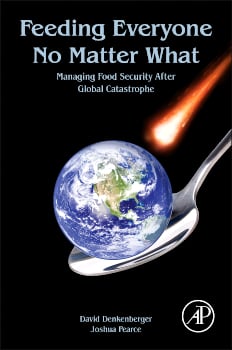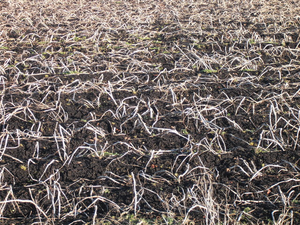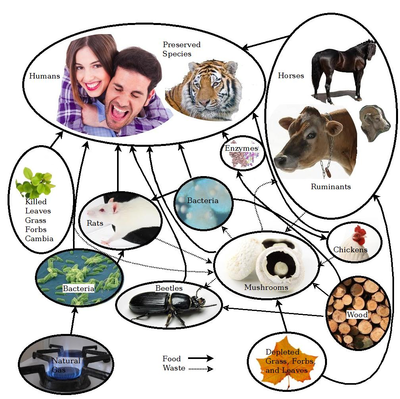
"Global Catastrophic Risks" collectively have ~1 in 10 probability of occurring per decade. With the possible exceptions of China, USA and South Korea, current resilience, financial systems and relief capacity are designed to mitigate only limited food price increases (such as in 2008 which was caused by impacts totalling <1% of global output) and not an abrupt 2-10% shock or worse, where without more preparedness it could be expected that governments, even with support from WFP and other major relief agencies, would be unable to source and distribute enough food to prevent food riots and government collapses. Without both internationals (industry, IMF, markets, Rapid Response Forum, UN insurers, disaster professionals, etc) and nationals (governments, broadcasters, private sector logistics, agriculture, etc.) having extraordinary stop-gap famine preparedness measures ready and stress tested, the run-up in global food prices would likely be much more severe than 2007-8 and last for months or years, leading to mass refugee flows, perhaps in unexpected directions. So food shortage and distribution problems or conflict could cause "actual global famine", with widespread economic collapses, potentially putting 100 million people at risk of starvation and within 2 year conceivably up to 2 billion deaths across Africa, Asia, the Middle East and the Americas. As a duty of care, current learning in integrative risk management can and should be scaled up to address such risks through the UN Sendai process, building on the Hyogo framework. The IMF, World Bank, Chatham House and several governments (e.g. UK and USA) are looking at specific aspects of this, leaving many gaps, especially in relation to Africa, Asia and the Americas where (e.g.) Nigeria, Brazil and India have additional challenges such as distribution and total population.
We explore some possible responses, preparedness options, research gaps and usefulness of "alternate foods" such as quick diversion of modified biofuels to edible oils/carbs and innovative uses of residues, waste, leaves, woody matter, methane and bacteria. These options together with distribution readiness would dramatically reduce mortality in a global catastrophic risk event. Food secure continents attract more sustained investment. Some of the preparedness options and alternate foods have further present time benefits, making them more easily fundable. Being well-prepared globally can reduce the likelihood of panic export bans and other self-defeating options in the future, and build present time trust/cooperation between countries, continents and industries, preventing beggar-thy-neighbour scenarios.
We make suggestions for the Hyogo / Sendai framework and to the risk and disaster communities for (1) immediately doable preparedness actions with high value and low cost per life saved, and (2) initial assessments and research (3) integration and knowledge exchange opportunities (4) funding strategies and financial sustainability.
Keywords[edit | edit source]

solar storm, high-altitude electromagnetic pulse, computer virus, global catastrophic risk, existential risk, industry, food, Lloyds of London, multiple bread basket failure, global catastrophic famine, catastrophe preparedness, World Food Program (WFP)
See also[edit | edit source]

- Feeding Everyone No Matter What - The full book main page
- David Denkenberger and Joshua Pearce, Feeding Everyone No Matter What: Managing Food Security After Global Catastrophe , 1st Edition, Academic Press, 2015
- Free Preview: Google books
- Cover on Academia
- Facebook page
- Alternative Foods as a Solution to Global Food Supply Catastrophes
- Resilience to global food supply catastrophes
- Feeding Everyone if the Sun is Obscured and Industry is Disabled
- Cost-Effectiveness of Interventions for Alternate Food to Address Agricultural Catastrophes Globally
- Feeding Everyone: Solving the Food Crisis in Event of Global Catastrophes that Kill Crops or Obscure the Sun
- Food without sun: Price and life-saving potential
- Cost-effectiveness of interventions for alternate food in the United States to address agricultural catastrophes
- Micronutrient Availability in Alternative Foods During Agricultural Catastrophes
- Preliminary Automated Determination of Edibility of Alternative Foods: Non-Targeted Screening for Toxins in Red Maple Leaf Concentrate
- Open Source Software Toolchain for Automated Non-Targeted Screening for Toxins in Alternative Foods
- Scaling of greenhouse crop production in low sunlight scenarios
- Potential of microbial protein from hydrogen for preventing mass starvation in catastrophic scenarios
- U.S. Potential of Sustainable Backyard Distributed Animal and Plant Protein Production During & After Pandemics
- Global distribution of forest classes and leaf biomass for use as alternative foods to minimize malnutrition
- Long-term cost-effectiveness of interventions for loss of electricity/industry compared to artificial general intelligence safety
- Long term cost-effectiveness of resilient foods for global catastrophes compared to artificial general intelligence safety
- Rapid repurposing of pulp and paper mills, biorefineries, and breweries for lignocellulosic sugar production in global food catastrophes
- Nutrition in Abrupt Sunlight Reduction Scenarios: Envisioning Feasible Balanced Diets on Resilient Foods
- Methane Single Cell Protein: securing protein supply during global food catastrophes
- Killing two birds with one stone: chemical and biological upcycling of polyethylene terephthalate plastics into food
- How Easy is it to Feed Everyone? Economic Alternatives to Eliminate Human Nutrition Deficits
- Quantifying Alternative Food Potential of Agricultural Residue in Rural Communities of Sub-Saharan Africa
- Yield and Toxin Analysis of Leaf Protein Concentrate from Common North American Coniferous Trees
- Toxic Analysis of Leaf Protein Concentrate Regarding Common Agricultural Residues
- Towards Sustainable Protein Sources: The Thermal and Rheological Properties of Alternative Proteins
Additional Information[edit source]
- ALLFED
- Dave Denkenberger Publications
- OSE Wiki "Synfood" (i.e. protein and other dietary components from microbial organisms fed on gas or other hydrocarbons)







